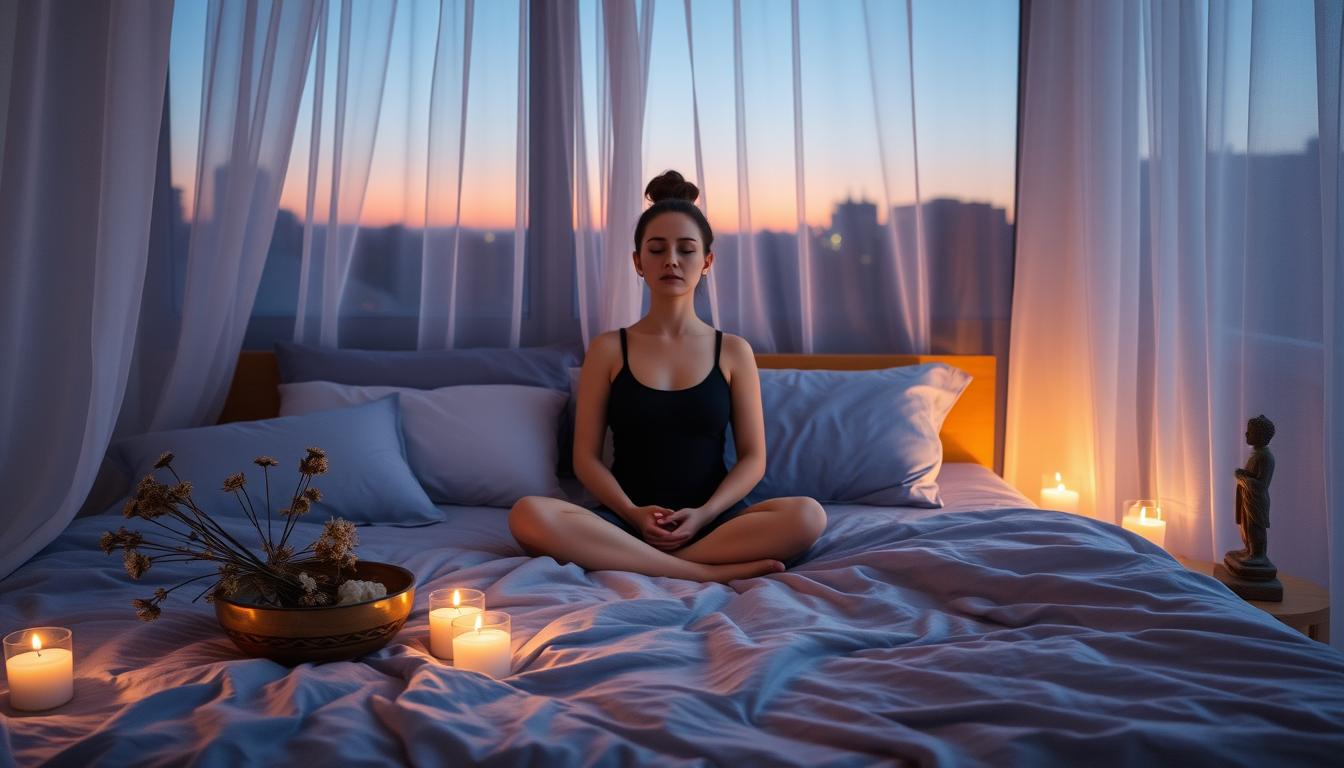Modern life keeps many of us alert long after sunset. Racing thoughts and tense muscles can make falling asleep feel like a battle. This is where intentional evening habits shine—they help your body and mind shift gears naturally.
Your brain starts preparing for rest hours before you lie down. Consistent nightly patterns tap into this biological process, using repetitive actions to signal it’s time to recharge. Studies reveal that structured pre-sleep activities improve how quickly you drift off and how deeply you stay asleep.
Gentle practices like focused breathing or gratitude journaling activate your body’s relaxation response. This physical shift slows your heart rate and quiets mental chatter. Unlike sleep supplements, these methods build lasting skills for managing stress and tension.
We’ll explore practical strategies backed by sleep science. From adjusting light exposure to simple breathing exercises, you’ll discover ways to transform evenings into a peaceful launchpad for rejuvenation.
Key Takeaways
- Evening habits align with your body’s natural wind-down process
- Relaxation techniques activate physical calm within minutes
- Consistency strengthens sleep signals over time
- Pre-bed activities improve both falling and staying asleep
- Mind-body practices offer lasting benefits beyond quick fixes
Introduction to Bedtime Mindfulness Rituals
Nighttime tranquility often eludes those tethered to digital devices and endless tasks. Our bodies crave predictable patterns, yet modern evenings overflow with emails, social updates, and household demands. This disconnect creates a biological tug-of-war between exhaustion and alertness.
Why Your Brain Needs Clear Signals
Daily rhythms thrive on consistency. Structured evening patterns act like an off-ramp for your nervous system, steering it away from daytime stress responses. Research shows repeating the same pre-sleep actions for just three nights can improve sleep onset by 40%.
Consider how screens hijack this process. Blue light from devices mimics sunlight, confusing your internal clock. Pairing device-free time with calming activities helps restore natural wake-sleep cycles.
The Science of Present-Moment Awareness
Focusing on your breath or body sensations triggers measurable changes. One study found seven minutes of mindful breathing lowers cortisol levels by 15%. This biological shift prepares both mind and body for deeper rest.
Simple practices work best. Try counting breaths while noticing how sheets feel against your skin. These concrete anchors ground racing thoughts, creating space between daily stresses and sleep preparation.
How Sleep Affects Your Body and Mind
Sleep isn’t just downtime—it’s when your body performs its most vital maintenance. A sophisticated internal clock called the circadian rhythm orchestrates everything from hormone release to cell repair. This 24-hour cycle responds to light changes, temperature shifts, and even your daily habits.
The Rhythm of Restoration
As daylight fades, your pineal gland releases melatonin—a hormone that lowers your core temperature by 1-2°F. This temperature dip explains why warm baths help: your body cools faster afterward, mimicking nature’s design. Consistent sleep schedules strengthen this rhythm, making rest more refreshing.
Your brain uses these quiet hours for critical tasks. It flushes waste products, sorts memories, and processes emotions. Think of it as nightly file organization for your mental hard drive.
Daytime Choices, Nighttime Consequences
Chronic stress acts like an alarm bell that won’t shut off. Elevated cortisol levels disrupt melatonin production, keeping your system on high alert. Late screen time compounds this by tricking your body into thinking it’s still daytime.
Simple adjustments make a difference. Eating earlier, reducing evening caffeine, and dimming lights after sunset align with your biology. When you sync with these natural processes, you’re not just sleeping better—you’re supporting long-term health.
Understanding these connections turns rest from a challenge into a partnership with your body’s wisdom. Next, we’ll explore how consistent routines amplify these benefits.
Benefits of a Consistent Bedtime Routine
Consistency in evening habits acts like a lullaby for your nervous system. Repeating specific actions before bed programs your biology to anticipate rest, creating a bridge between daily activity and deep recovery.
Reducing Stress Through Predictable Patterns
Your brain loves patterns. When you follow the same sequence each night—like reading followed by stretching—it stops scanning for threats. This predictability lowers cortisol levels by up to 20% according to recent studies.
A structured wind-down period helps separate work stress from personal time. People who maintain regular pre-sleep habits report 35% fewer nighttime worries. Your body learns to associate these actions with safety, easing tension in muscles and mind.
Sleep Quality and Physical Wellness
Consistent routines don’t just help you fall asleep faster—they enhance how you rest. Those sticking to regular schedules experience 25% more deep sleep cycles. This stage repairs tissues and consolidates memories.
Better sleep architecture strengthens immunity and balances hunger hormones. One study found adults with steady bedtime habits had 30% fewer sick days. Your evening routine becomes daily maintenance for both brain and body.
These habits create ripple effects. Improved rest sharpens focus during waking hours and helps regulate emotions. Over time, your entire system operates more smoothly when fueled by quality sleep.
Essential “bedtime mindfulness rituals to” Calm Your Mind and Body
Evening hours offer a natural transition from activity to rest. Simple techniques can help bridge this shift, creating space between daily stresses and restorative sleep. Let’s explore accessible methods backed by sleep researchers.
Simple Exercises to Try Tonight
Deep breathing anchors your awareness. Try inhaling for four counts, holding for seven, then exhaling for eight. This 4-7-8 method slows heart rates by 10-15% within minutes, according to Arizona sleep studies.
Progressive muscle relaxation works like a tension audit. Tighten each muscle group for five seconds, then release. Start with toes and move upward. Many discover hidden stress in their jaw or shoulders this way.
| Technique | Benefit | Suggested Time |
|---|---|---|
| Body Scan | Releases physical tension | 7 minutes |
| Loving-Kindness | Reduces emotional turbulence | 5 minutes |
| Mindful Breathing | Calms racing thoughts | 3-10 minutes |
Short sessions matter most. As Dr. Sara Mednick notes: “Five minutes of focused practice often proves more effective than thirty forced ones.” Start small—even three minutes helps build consistency.
These methods teach your system to release rather than resist. Over time, they become automatic pathways to deeper rest, helping you fall asleep faster and wake refreshed.
Developing a Personalized Bedtime Meditation Practice
Tailoring your evening wind-down requires methods that fit your unique needs. Meditation offers flexible tools to quiet mental noise, but their power lies in personal adaptation. The key? Experimentation paired with gentle consistency.
Crafting Your Meditation Space
Choose a quiet corner where you can sit upright without distractions. A cushioned chair or folded blanket works well. This designated place becomes your daily anchor, training your brain to shift gears.
Breathing Techniques for Beginners
Start with five minutes of diaphragmatic breathing. Place one hand on your chest, the other below your ribs. Inhale deeply until only the lower hand rises. This activates your body’s relaxation response within 90 seconds.
| Style | Focus | Duration |
|---|---|---|
| Free-Writing | Releasing mental clutter | 7-10 minutes |
| Mantra | Concentration | 5 minutes |
| Body Scan | Physical awareness | 8 minutes |
“Three focused minutes daily builds neural pathways faster than occasional hour-long sessions.”
When thoughts arise during practice, visualize them as leaves floating down a stream. Notice without grabbing. This mental muscle strengthens with repetition, making it easier to release daytime stresses.
Keep a notebook nearby for free-writing bursts. Set a timer, then scribble whatever comes up—no editing allowed. Many find this “brain drain” creates space for calm. Remember: progress matters more than perfection.
Journaling and Gratitude Techniques to Clear Your Mind
Putting pen to paper at night unlocks mental clarity while preparing your system for rest. Studies reveal that writing for just five minutes reduces sleep latency by 28%. This simple practice creates space between daily stresses and restorative sleep.
Stream-of-Consciousness Writing Basics
Free-writing works like a mental pressure valve. Set a timer for 10 minutes and write without stopping or editing. Let thoughts flow freely—even if they seem disjointed. Research shows this technique reduces nighttime anxiety by 37%.
| Method | Focus | Sleep Impact |
|---|---|---|
| Free-Writing | Emotional release | Faster sleep onset |
| To-Do Lists | Task management | Fewer wake-ups |
| Gratitude Lists | Positive focus | Deeper REM cycles |
Harnessing Positive Reflection
End your journaling session with three specific moments from your day. Did your morning coffee taste exceptional? Did a coworker offer kind words? These small anchors shift your mind from problem-solving to appreciation mode.
“Listing tomorrow’s tasks takes mental sticky notes off repeat mode.”
Keep your journal accessible but screen-free. The physical act of writing engages different brain regions than typing. Over time, this nightly ritual becomes your mind’s off-ramp from daily chaos to peaceful rest.
Setting Up an Ideal Sleep Environment
Your surroundings play a crucial role in signaling it’s time to rest. Three elements work together to create optimal conditions: managing light exposure, regulating temperature, and minimizing distractions. When these factors align, your bedroom becomes a sanctuary that supports natural sleep cycles.
Outsmarting Blue Light Traps
Screens from phones or tablets emit wavelengths that suppress melatonin by 23% within two hours. Charge devices outside your bed area to avoid late-night social media scrolling. For evening tasks requiring screens, enable red-tinted night modes—they’re 50% less disruptive than standard settings.
Crafting Comfort Through Climate
Set your thermostat between 65-68°F—the sweet spot where most bodies cool efficiently for sleep. Pair this with blackout curtains to block streetlights and early sunrises. A tidy space matters too: cluttered rooms can increase stress hormones by 15% according to Princeton researchers.
Soft textures and calming scents like lavender enhance relaxation. Try a weighted blanket or white noise machine if outside sounds intrude. These tweaks transform your bedroom into a haven where rest comes naturally, night after night.







